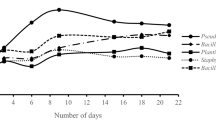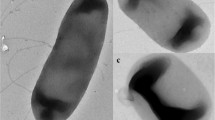Abstract
Soil hydrocarbon pollution often causes the crop quality and safety issue. Therefore, a high priority is given to exploring the novel bacterial strain to sustainable green agricultural food products. Two novel crude oil-degrading bacteria were screened from the local oil-contaminated soil, which exhibited a good emulsifying capacity in their oil spreading test, showing their most clearing zone on the oil covering petri dish. Glycolipid bio-surfactant was identified by the thin-layer chromatography analysis. Gas chromatography and ultraviolet spectrophotometer (UV) methods were used to evaluate the degradation degree of alkanes and aromatic hydrocarbons in crude oil. The biodegradation ability of a single strain was inferior to mixed strains. The latter revealed that the degradation of the crude oil was 92% and 85%, respectively, when cultured at 32 °C, 150 rpm for 20 days. The hardest degraded isoprenoid alkane (pristane) could easily be degraded by these mixed strains. The effect of cadmium (Cd) on the growth of isolated strains was also studied, and the results demonstrate that crude oil-degrading bacteria isolated in the present study have shown strong endurance to Cd2+ (IC50 were 228.80 mg L−1 and 97.74 mg L−1) for Pseudomonas aeruginosa Dut-lxm0725 and Rhodococcus erythropolis Dut-lxm1018 strains, respectively. The above results suggest that present wild strains could have a good application prospect in bioremediation of crude oil-contaminated soil.









Similar content being viewed by others
References
Brinkmann D, Röhrs J, Schügerl K (1998) Bioremediation of diesel fuel contaminated soil in a rotating bioreactor part I: influence of oxygen saturation. Chem Eng Technol 21(2):168–172
Cai M, Yao J, Yang H, Wang R, Masakorala K (2013) Aerobic biodegradation process of petroleum and pathway of main compounds in water flooding well of Dagang oil field. Bioresour Technol 144:100–106
Cerqueira VS, Hollenbach EB, Maboni F, Vainstein MH, Camargo FAO, Peralba MDCR, Bento FM (2011) Biodegradation potential of oily sludge by pure and mixed bacterial cultures. Bioresour Technol 102(23):11003–11010
Dussán J, Numpaque M (2012) Degradation of diesel, a component of the explosive ANFO, by bacteria selected from an open cast coal mine in La Guajira, Colombia. J Bioprocess Biotech 02(04):1–5. https://doi.org/10.4172/2155-9821.1000126
Gondal MA, Hussain T, Yamani ZH, Baig MA (2006) Detection of heavy metals in Arabian crude oil residue using laser induced breakdown spectroscopy. Talanta 69:1072–1078
Habib A, Mir MH, Tayebe BL, Hossein SZ, Sharafi H, Masoomi F, Moosavi-Movahedi AA, Ortiz A, Amanlou M, Noghabi KA (2012) Biosurfactant-producing bacterium, Pseudomonas aeruginosa MA01 isolated from spoiled apples: physicochemical and structural characteristics of isolated biosurfactant. J Biosci Bioeng 113(2):211–219
Haryati J, Dalila MZ, Zaharah I (2012) Isolation of metal tolerant bacteria from polluted wastewater. Pertanika J Trop Agric Sci 35(3):647–662
Hong L, Hang W, Chen XH, Liu N, Suriguge B (2014) Biosurfactant-producing strains in enhancing solubilization and biodegradation of petroleum hydrocarbons in groundwater. Environ Monit Assess 186:4581–4589
Howard WM, Wang GD, Christopher RG, Eric TP, Bin L, Quach VN (2004) PAHs and metals in the soils of inner-city and suburban New Orleans, Louisiana, USA. Environ Toxicol Pharmacol 18:243–247
Ideriah TJK, Ikpe FN, Nwanjoku FN (2013) Distribution and speciation of heavy metals in crude oil contaminated soils from Niger Delta, Nigeria. World Environ 3(1):18–28
Kisic L, Mesic S, Basic F, Brkic V, Mesic M, Durn G, Zgorelec Z, Bertovic L (2009) The effect of drilling fluids and crude oil on some chemical characteristics of soil and crops. Geoderma 149:209–216
Koshlaf E, Shahsavari E, Aburto-Medina A, Taha M, Haleyur N, Makadia TH, Morrison PD, Ball AS (2016) Bioremediation potential of diesel-contaminated Libyan soil. Ecotoxicol Environ Safe 133:297–305
Lan G, Fan Q, Liu Y, Liu Y, Liu Y, Yin X, Luo M (2015) Effects of the addition of waste cooking oil on heavy crude oil biodegradation and microbial enhanced oil recovery using Pseudomonas sp. SWP-4. Biochem Eng J 103:219–226
Lian J, Ha Y, Huang L, Ju Y, Shi S, Liu L, Zhang R, Sui H, Li X (2011) Biological toxicity effect of petroleum contaminated soil before and after physicochemical remediation (Chinese). Environ Sci 32(3):870–874
Liu B, Ju M, Liu J, Wu W, Li X (2016) Isolation, identification, and crude oil degradation characteristics of a high-temperature, hydrocarbon-degrading strain. Mar Pollut Bull 106:301–307
Maddela NR, Burgos R, Kadiyala V, Carrion AR, Bangeppagari M (2016) Removal of petroleum hydrocarbons from crude oil in solid and slurry phase by mixed soil microorganisms isolated from Ecuadorian oil fields. Int Biodeterior Biodegradation 108:85–90
Mittal A, Singh P (2009) Isolation of hydrocarbon degrading bacteria from soils contaminated with crude oil spills. Indian J Exp Biol 47(9):760–765
Mohammed UM, Normala H (2015) Screening and isolation of heavy metal tolerant bacteria in industrial effluent. Proc Environ Sci 30:33–37
Navjot K, Todd E, Andrew S, Megan H (2017) A review of germination and early growth as a proxy for plant fitness under petrogenic contamination knowledge gaps and recommendations. Sci Total Environ 603:728–744
Okoh AI (2006) Biodegradation alternative in the cleanup of petroleum hydrocarbon pollutants. Biotechnol Mol Biol Rev 1(2):38–50
Pereira JSF, Moraes DP, Antes FG, Diehl LO, Santos MFP, Guimarães RCL, Fonseca TCO, Dressler VL, Flores ÉMM (2010) Determination of metals and metalloids in light and heavy crude oil by ICP-MS after digestion by microwave-induced combustion. Microchem J 96(1):4–11
Pi NR, Burgos R, Kadiyala V, Carrion AR, Bangeppagari M (2016a) Removal of petroleum hydrocarbons from crude oil in solid and slurry phase by mixed soil microorganisms isolated from Ecuadorian oil fields. Int Biodeterior Biodegradation 108:85–90
Pi Y, Meng L, Bao M, Sun P, Lu J (2016b) Degradation of crude oil and relationship with bacteria and enzymatic activities in laboratory testing. Int Biodeterior Biodegradation 106:106–116
Pi Y, Chen B, Bao M, Fan F, Cai Q, Ze L, Zhang B (2017) Microbial degradation of four crude oil by biosurfactant producing strain Rhodococcus sp. Bioresour Technol 232:263–269
Rahman KSM, Banat IM, Thahira J, Thayumanavan T, Lakshmanaperumalsamy P (2002) Bioremediation of gasoline contaminated soil by a bacterial consortium amended with poultry litter, coir pith and rhamnolipid biosurfactant. Bioresour Technol 81(1):25–32
Rizvi A, Khan MS (2017) Biotoxic impact of heavy metals on growth, oxidative stress and morphological changes in root structure of wheat (Triticum aestivum L.) and stress alleviation by Pseudomonas aeruginosa strain CPSB1. Chemosphere 185:942–952
Rodrigues LR, Teixeira JA, van der Mei HC, Oliveira R (2006) Physicochemical and functional characterization of a biosurfactant produced by Lactococcus lactis 53. Colloids Surf B 49:78–85
Ron EZ, Rosenberg E (2014) Enhanced bioremediation of oil spills in the sea. Curr Opin Biotechnol 27:191–194
Rontani J, Bonin P (2011) Production of pristane and phytane in the marine environment: role of prokaryotes. Res Microbiol 162(9):923–933
Sangeeta C, Pinaki S (2011) Uranium biomineralization by a metal resistant Pseudomonas aeruginosa strain isolated from contaminated mine waste. J Hazard Mater 186:336–343
Smith MJ, Flowers TH, Duncan HJ, Alder J (2006) Effects of polycyclic aromatic hydrocarbons on germination and subsequent growth of grasses and legumes in freshly contaminated soil and soil with aged PAHs residues. Environ Pollut 141(3):519–525
Sarwar N, Imran M, Shaheen MR, Ishaque W, Kamran MA, Matloob A, Rehim A, Hussain S (2017) Phytoremediation strategies for soils contaminated with heavy metals: modifications and future perspectives. Chemosphere 171:710–721
Tahseen R, Afzal M, Iqbal S, Shabir G, Khan QM, Khalid ZM, Banat IM (2016) Rhamnolipids and nutrients boost remediation of crude oil-contaminated soil by enhancing bacterial colonization and metabolic activities. Int Biodeterior Biodegradation 115:192–198
Tanti B, Buragohain AK (2013) Biodegradation of petroleum tar by Pseudomonas Spp. from oil field of Assam, India. Bioremediat J 17(2):107–112
Varjani SJ (2017) Microbial degradation of petroleum hydrocarbons. Bioresour Technol 223:277–286
Varjani SJ, Rana DP, Jain AK, Bateja S, Upasani VN (2015) Synergistic ex situ biodegradation of crude oil by halotolerant bacterial consortium of indigenous strains isolated from on shore sites of Gujarat, India. Int Biodeterior Biodegradation 103:116–124
Xia XH, Yu H, Yang ZF, Huang GH (2006) Biodegradation of polycyclic aromatic hydrocarbons in the natural waters of the Yellow River: effects of high sediment content on biodegradation. Chemosphere 65:457–466
Zeng GM, Chen AW, Chen GQ, Hu XJ, Guan S, Cui S, Lu LH, Zou ZJ (2012) Responses of Phanerochaete chrysosporium to toxic pollutants: physiological flux, oxidative stress, and detoxification. Environ Sci Technol 46:7818–7825
Zhang XS, Xu DJ, Zhu CY, Tserennyam L, Kerstin ES (2012) Isolation and identification of biosurfactant producing and crude oil degrading Pseudomonas aeruginosa strains. Chem Eng J 209:138–146
Zloch M, Dominika T, Renata GK, Katarzyna H (2016) Synthesis of siderophores by plant-associated metallotolerant bacteria under exposure to Cd2+. Chemosphere 156:312–325
Acknowledgements
This work was supported by the National Natural Science Foundation of China (41603069) and the Fundamental Research Funds for the Central Universities Grants from Dalian University of Technology (DUT14QY48, DUT15QY54).
Author information
Authors and Affiliations
Corresponding author
Ethics declarations
Conflict of interest
The authors declare that they have no conflict of interest.
Additional information
Editorial responsibility: Dr. J Aravind, M.Tech, Ph.D.
Electronic supplementary material
Below is the link to the electronic supplementary material.
Rights and permissions
About this article
Cite this article
Russel, M., Li, X., Qu, M. et al. Exploring the novel indigenous strains for degrading the crude oil contaminants in soil sample. Int. J. Environ. Sci. Technol. 16, 5657–5668 (2019). https://doi.org/10.1007/s13762-018-1945-y
Received:
Revised:
Accepted:
Published:
Issue Date:
DOI: https://doi.org/10.1007/s13762-018-1945-y




